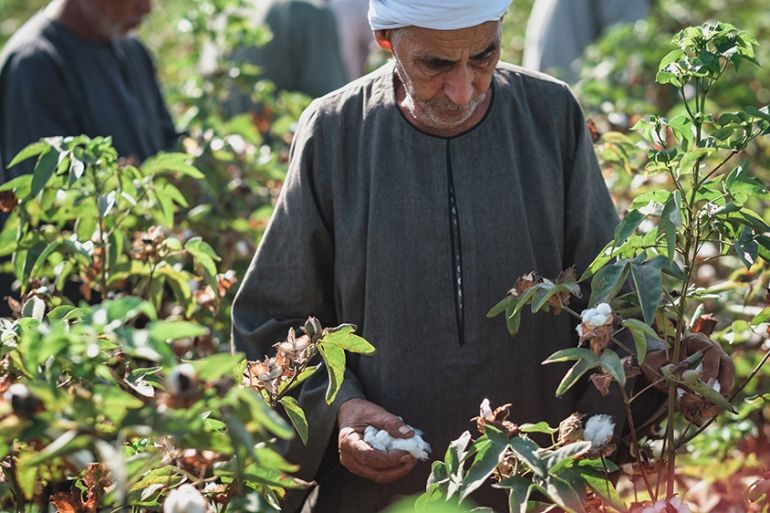Sustainable fashion: Good for the world, but worth the price?
Some sustainable fashion brands are betting helping shoppers track a garment’s ‘story’ can justify higher prices.

Rana Plaza was a multi-storey building in Bangladesh’s Dhaka district – home to clothing factories, apartments, stores and a bank.

In 2013, thousands of workers were inside when it crumbled, more than 1,100 people died, many more were injured. It was one of the world’s worst industrial disasters.
The tragedy spurred an industry-wide effort to make garment factories safer. It also energised the “sustainable fashion” movement. The term describes the practice of making ecological integrity and social justice key factors of production and distribution within the fashion industry, but that effort often increases costs.
Keep reading
list of 4 itemsBehind India’s Manipur conflict: A tale of drugs, armed groups and politics
China’s economy beats expectations, growing 5.3 percent in first quarter
Inside the pressures facing Quebec’s billion-dollar maple syrup industry
Businesses and entrepreneurs who want to embrace sustainable fashion face two challenges: remaining competitive and convincing shoppers that the sustainable qualities of a garment are worth a higher price.
Sustainable fashion’s extra costs
Four years ago Rami Helali cofounded Kotn, a fashion label. The company’s stated goal is to “ethically produce” wardrobe staples. To that end, the 30 year old set up a supply chain in Egypt that starts with farmers, and did so knowing his production costs would likely be higher than his competitors’.
To get material for his line of clothing, Helali bypassed middlemen and worked directly with several small-holder farms, which were plentiful because, during Egypt’s brief experiment with communism in the 1960s, large swaths of land were divided into smaller plots and redistributed among low-income farmers.

Helali offered farmers guaranteed prices for their cotton and subsidized the cost of agricultural consulting and fertilisers. He thereby brought down the cost of raw materials while increasing revenue for farmers. He then recruited yarn and fabric companies, dye houses and cut-and-sew manufacturers to ensure he could track “every single person that touches the garment“, he told Al Jazeera.
To reduce the number of its clothes that end up in landfills, Kotn offers few styles and avoids trend-based fashion. To understand the significance of that decision, consider this: Data from the United States Environmental Protection Agency shows nearly 70 percent of discarded clothing and footwear in the US ends up in landfills.
Pricing has always been a sore point for sustainable brands because the so-called “sustainable elements” increase production costs. According to a 2019 Nielsen report, 73 percent of global consumers claimed they would be willing to change consumption habits to reduce their effect on the environment, yet only 41 percent said they were willing to pay more for natural products. The difference between those two numbers underscores sustainable fashion’s major challenge.
At Kotn, a simple T-shirt is priced upwards of $25 and a pair of sweatpants retails for $68. Compare those prices with similar offerings by brands like H&M and GAP where T-shirts retail at an average of $9.99 and a pair of sweatpants for $25.99.
Worth a higher price?
To justify these higher prices, brands like Kotn heavily rely on digital, social and e-commerce platforms to reinforce their product’s background story.

“Customers are willing to spend a little more for a brand’s story they understand and a product they can feel good about,” adds Helali. His company started out selling a cotton T-shirt in 2015 and now has grown to include a direct-to-consumer online platform and three bricks-and-mortar stores. He told Al Jazeera, Kotn has grown 37 percent month-on-month since launching.
The Seattle-based shoe company, Fuchsia uses blockchain platform Provenance to share details about the workers who hand-make their shoes in Pakistan. According to a case study, the company saw a 31 percent increase in the number of people who visited its website and actually made a purchase. Separately, the study noted a 45 percent boost in engagement on social platforms just six months after implementing blockchain technology.
“If we want the world to exist in 100 years, there has to be a fundamental shift in how we consume and how we produce,” said Helali. “Because the status quo just doesn’t work any more.”
Tracking a garment’s story
Some entrepreneurs are betting blockchain technology can increase transparency and communication in the fashion industry, by tracking every stop a product makes along the supply chain.
Blockchain, the distributed ledger technology best known for underpinning Bitcoin, allows a network of computers to verify “blocks” of transactions rather than rely on a centralised authority to guarantee trust. This eliminates single points of failure when verifying a product’s origins.
“We’re finding that there’s a new type of digitally savvy consumer who is demanding more information about the goods they buy,” says Jessi Baker who launched Provenancein 2013, a company that enables growing businesses to track products and working conditions using blockchain technology, which also helps weed out counterfeit items.

Martine Jarlgaard, a London-based sustainable fashion brand, uses Provenance-empowered blockchain to track the journey of raw alpaca fleece from the farm to the finished garment. Each garment has a unique digital token, enabling Provenance to verify every step of its production and create a digital history including location data, content and timestamps. Shoppers can access that data via an interface accessible through an item’s QR code or NFC-enabled label.
“Medium and small businesses have a competitive edge on larger players in that their supply chains are often easier to manage due to the sheer scale,” says Baker. “This allows them to make the leap much quicker to being an open and honest business without all of the tiers and stakeholders involved.”
Meanwhile, researchers at the Harvard T H Chan School of Public Health are engaging directly with larger companies to establish effective communication channels to shed light on the culture of wellbeing and health through a unique project called SHINE.
“There is a direct correlation between business performance and employee wellbeing,” says Piotr Białowolski, a research associate on the SHINE team. Białowolski’s research found that feedback about poor working conditions, low pay and non-functioning equipment is often withheld by factory workers from upper management due to fear of backlash from ground supervisors and managers with whom they interact daily.
While SHINE’s work is still in the research stages, they recently teamed up with Levi Strauss & Co to launch a worker wellbeing survey that recorded factory employees’ answers anonymously on a blockchain platform, starting with a vendor in Mexico that employs 4,000 people.
In a post on the company’s blog, Levi Strauss Foundation’s Kim Almeida said that because some employees might be hesitant to speak out about direct managers, the anonymity of blockchain is “critical”.
Although this was their first pilot programme, Levi Strauss & Co noted that it is already seeing benefits in terms of how quickly it can collect feedback and share results.
Despite the brand’s intentions, a recent NYU Stern report found that garment workers in Ethiopia are still underpaid at factories producing clothes for Levi’s, among other high-street giants. Most high-street labels outsource production to individual manufacturers in developing countries where labour is cheap and readily available.
“Every factory promises maximum output at minimum costs to retain contracts,” says Białowolski. “And most brands are price-conscious. In the end, the workers end up getting exploited.”
While small-scale businesses such as Kotn are equipped to control every step of their supply chain, for bigger brands, change has been slow to come.